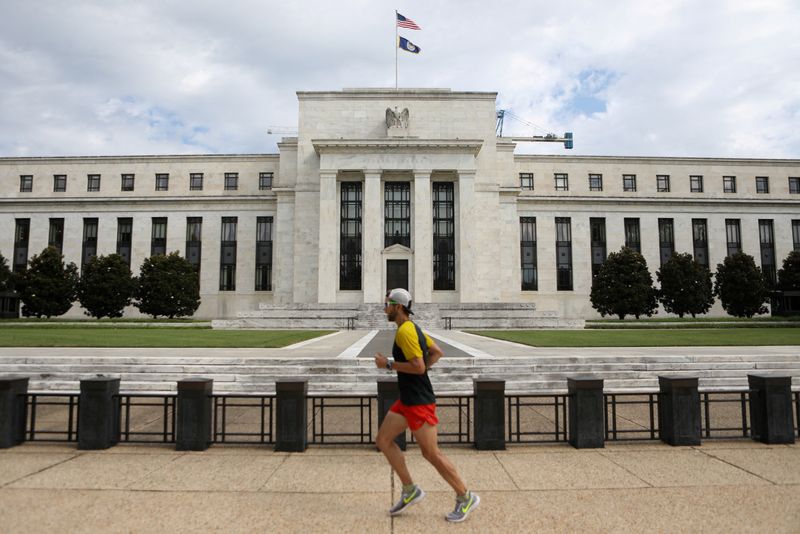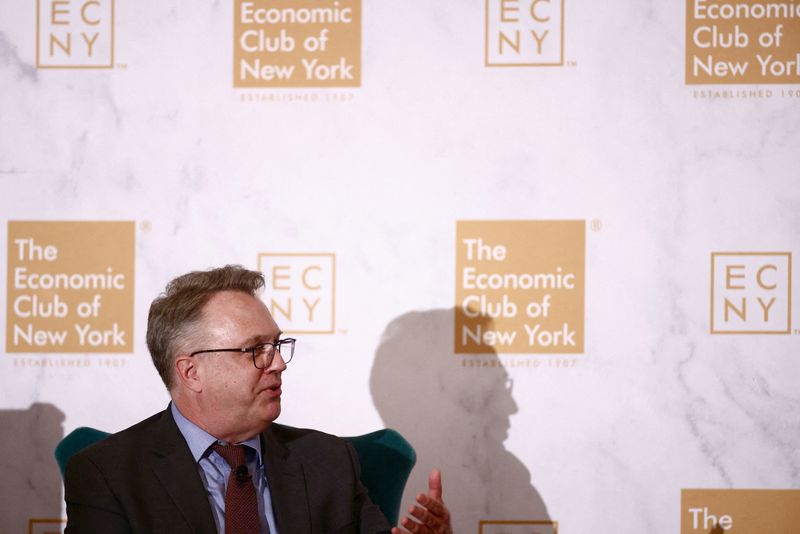By Howard Schneider
WASHINGTON (Reuters) - Investors have locked onto the U.S. central bank's Sept. 17-18 meeting for the start of interest rate cuts that Federal Reserve Chair Jerome Powell has said will represent a "consequential" change in policy from the pandemic-era battle against inflation to a phase of easing monetary policy.
Where the process ends up is uncertain. Shifts in supply and investment patterns during the COVID-19 era, new geopolitical tensions, even the risk of tariff wars instigated by a potential second Trump administration could make the Fed's exit from high interest rates as challenging as its fight against inflation.
But the initial turn, at least, appears close.
Whether September marks the starting point will depend on data behaving close to what Fed officials expect, with continued progress on lowering inflation towards the central bank's 2% target and a labor market staying in rough balance with modest wage and monthly job gains.
The Fed is expected to hold its benchmark interest rate steady in the 5.25%-5.50% range at its July 30-31 meeting, but its new policy statement may also change the descriptions of the economy and outlook to lay the groundwork for a rate cut in September.
The seven-week gap between the July and September meetings is a week longer than usual, allowing for more data to accumulate. It also includes the Kansas City Fed's annual research conference in Jackson Hole, Wyoming, a venue often used by Fed chiefs to deliver policy-relevant messages.
"We're actually going to learn a lot between July and September," New York Fed President John Williams said in a recent Wall Street Journal interview.
HOW THEY GOT HERE
After downplaying the pandemic-triggered inflation shock as "transitory," the Fed beginning in March 2022 launched what became a historically rapid rise in interest rates after policymakers accepted that price pressures were going to persist and became worried about losing public confidence.
Over the course of 12 policy meetings the Fed raised its benchmark rate by 5.25 percentage points, averaging nearly half a percentage point per meeting. That included four consecutive hikes of three-quarters of a percentage point that were meant to both send a message of resolve about taming inflation and catch up after what many monetary policy rules suggested was a late and slow start to the tightening cycle.
The Fed's policy rate last July reached roughly the same level as during the run-up to the 2007-2009 financial crisis, and the central bank has held it there since. The length of this period of "restrictive" interest rates will likely rank in the middle of other recent Fed monetary policy cycles.
But that's because of the positive inflation surprises officials got last year when supply chains and labor markets began behaving more like they did before the pandemic. Much of the inflation shock did prove "transitory," just at a slower pace than policymakers' initially anticipated.
WILL DISINFLATION CONTINUE?
In their final comments before the upcoming policy meeting, Fed officials said they thought inflation is likely to continue slowing, and rate cuts would be appropriate if it does.
Inflation, based on the Fed's preferred personal consumption expenditures price index, was 2.6% in May, and many economists expect it to dip to 2.5% or lower when the data for June is released on July 26.
Then, ahead of the September meeting, policymakers will receive a PCE release for July on Aug. 30, plus two consumer price index reports on Aug. 14 and Sept. 11, respectively, covering the July and August data. They'll also see wholesale prices data for both months.
Despite worries earlier this year that inflation was rebounding, recent data has shown a renewed slowing.
CAN THE JOB MARKET STAY AFLOAT?
Powell recently referred to the job market as being in "equilibrium," a phrase that in its fullest sense means the number of available workers is roughly balanced with firms' demand for labor; the monthly flow of new hires and people quitting is in line with population growth; and wage growth is coming into line with the Fed's inflation target.
The current 4.1% unemployment rate is about what central bank officials feel is sustainable in the long run with inflation at 2%, and policymakers are hopeful they will finish the inflation fight and start lowering rates without a substantial rise in joblessness.
Coming employment reports will be looked at to confirm that rising wages and labor shortages no longer pose an inflation risk, while signs of weakening could - if bad enough - influence the size and pace of future rate cuts. The unemployment rate has been rising slowly but steadily from last year's historic low of 3.4%, and some Fed officials have noted that often when the unemployment rate starts to rise, it eventually does so fast.
Before they gather in September, officials will receive the Labor Department's employment reports for July and August on Aug. 2 and Sept. 6, respectively. Data on jobless claims arrives weekly, and the figures have been rising, though the series is volatile and heavily influenced by seasonal factors.

Reports on job openings and worker quit levels for June and July will be released on July 30 and Sept. 4, respectively.
The Job Openings and Labor Turnover Survey data has played a surprisingly large role in recent Fed deliberations, an example of how the pandemic distorted the job market. With the ratio of job openings to unemployed and other aspects of the report returning to pre-pandemic levels, the JOLTS reports have shaped officials' view that the unemployment rate could start to rise if the Fed presses on the economy too hard for too long.
